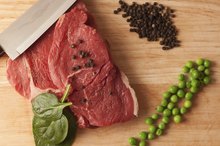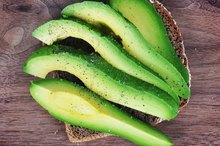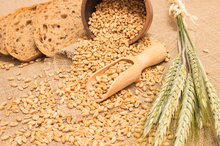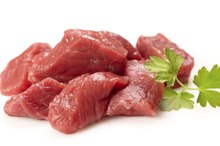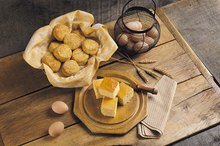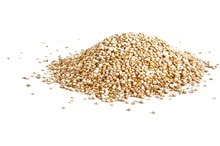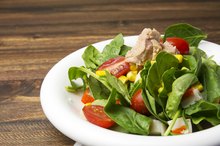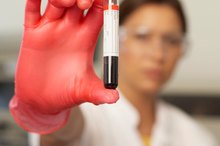What does fact checked mean?
At Healthfully, we strive to deliver objective content that is accurate and up-to-date. Our team periodically reviews articles in order to ensure content quality. The sources cited below consist of evidence from peer-reviewed journals, prominent medical organizations, academic associations, and government data.
- National Institutes of Health Office of Dietary Supplements: Iron
- National Institutes of Health Office of Dietary Supplements: Folate
The information contained on this site is for informational purposes only, and should not be used as a substitute for the advice of a professional health care provider. Please check with the appropriate physician regarding health questions and concerns. Although we strive to deliver accurate and up-to-date information, no guarantee to that effect is made.
Are Sunflower Seeds a Food High in Iron?
Sunflower seeds contain minimal saturated fat and no cholesterol, and they provide several important nutrients, including folate, protein and a small amount of iron. Sunflower seeds do not contain as much iron as animal-based iron sources or some plant-based iron sources such as legumes or fortified cereals, but they can help you fulfill your daily iron needs and prevent iron deficiency anemia. Iron plays an essential role in the transport of oxygen in the blood. Symptoms of iron deficiency include weakness, fatigue, shortness of breath and decreased immunity.
Iron in Sunflower Seeds
A 1/4-cup serving of sunflower seeds dry roasted with salt contains 1.22 mg of iron, according to the USDA National Nutrient Database. A 1 oz serving of sunflower seeds dry roasted with salt contains 1.08 mg of iron 2.
Percentage of Recommended Daily Intake
Do Beans Have Iron?
Learn More
Iron needs vary according to age and gender. Teenage girls and women of childbearing age should consume more iron per day because they lose iron during menstruation. Children ages 1 to 3 need 7 mg of iron per day, children ages 4 to 8 need 10 mg of iron per day and children ages 9 to 13 need 8 mg per day. Boys ages 14 to 17 need 11 mg per day, while girls ages 14 to 17 need 15 mg per day. Men ages 19 and over and women ages 51 and over need only 8 mg of iron per day, while women ages 19 to 50 need 18 mg per day. For many people, 1 oz serving of sunflower seeds provides a significant percentage of their daily iron needs. For children ages 9 to 13, men ages 19 and over and women ages 51 and over, a 1 oz serving of sunflower seeds provides 13.5 percent of daily iron needs.
- Iron needs vary according to age and gender.
- Men ages 19 and over and women ages 51 and over need only 8 mg of iron per day, while women ages 19 to 50 need 18 mg per day.
Iron Type
Animal-based iron sources such as:
- liver
- beef
- oysters
- fish
- egg yolks provide heme iron
- a type of iron that the body absorbs easily
Plant-based iron sources, such as sunflower seeds, contain nonheme iron, which the body absorbs less easily. Consuming animal-based proteins or foods rich in vitamin C along with nonheme iron sources can improve the body’s absorption of the nonheme iron.
Other Nutrients
List of Foods & Drinks High in Iron
Learn More
A 1 oz serving of sunflower seeds contains 165 calories, including 127 calories from fat, and 14.1 g of fat, including only 1.5 g of saturated fat. This serving also contains 6.8 g of carbohydrates, including 2.6 g of dietary fiber and 0.8 g sugar, and provides 5.5 g protein, 2 percent of your recommended daily calcium intake and 11 percent of your recommended daily folate intake.
Related Articles
References
- National Institutes of Health Office of Dietary Supplements: Iron
- Washington University in St. Louis: Sunflower Seeds Nutrition Facts
- National Institutes of Health Office of Dietary Supplements: Folate
- Office of Dietary Supplements - Dietary Supplement Fact Sheet: Iron. (n.d.). Retrieved August 11, 2016, from https://ods.od.nih.gov/factsheets/Iron-HealthProfessional/#h10.
- Trumbo, P., Yates, A. A., Schlicker, S., & Poos, M. (2001). Dietary reference intakes: vitamin A, vitamin K, arsenic, boron, chromium, copper, iodine, iron, manganese, molybdenum, nickel, silicon, vanadium, and zinc. Journal of the American Dietetic Association, 101(3), 294-301.
- Constantini, N. W., Eliakim, A., Zigel, L., Yaaron, M., & Falk, B. (2000). Iron status of highly active adolescents: evidence of depleted iron stores in gymnasts. International Journal of Sport Nutrition, 10(1), 62-70.
- Cowell, B. S., Rosenbloom, C. A., Skinner, R., & Summers, S. H. (2003). Policies on screening female athletes for iron deficiency in NCAA division IA institutions. International Journal of Sport Nutrition and Exercise Metabolism, 13, 277-285.
- Malczewska, J., SzczepaÅska, B., Stupnicki, R., & Sendecki, W. (2001). The assessment of frequency of iron deficiency in athletes from the transferrin receptor-ferritin index. International Journal of Sport Nutrition and Exercise Metabolism, 11(1), 42-52.
- Knovich, M. A., Storey, J. A., Coffman, L. G., Torti, S. V., & Torti, F. M. (2009). Ferritin for the clinician. Blood Reviews, 23(3), 95-104.
- Guyatt, G. H., Oxman, A. D., Ali, M., Willan, A., McIlroy, W., & Patterson, C. (1992). Laboratory diagnosis of iron-deficiency anemia. Journal of General Internal Medicine, 7(2), 145-153.
- Finch, C. A., Stray, S., Huebers, H. A., Bellotti, V., Lipschitz, D. A., Cook, J. D., & Pippard, M. J. (1986). Plasma ferritin determination as a diagnostic tool. Western Journal of Medicine, 145(5), 657.
- Hallberg, L., Brune, M., & Rossander, L. (1988). The role of vitamin C in iron absorption. International journal for vitamin and nutrition research. Supplement= Internationale Zeitschrift fur Vitamin-und Ernahrungsforschung. Supplement, 30, 103-108.
- Lane, D. J., & Richardson, D. R. (2014). The active role of vitamin C in mammalian iron metabolism: much more than just enhanced iron absorption! Free Radical Biology and Medicine, 75, 69-83.
- Bonsmann, S. S., Walczyk, T., Renggli, S., & Hurrell, R. F. (2008). Oxalic acid does not influence nonhaem iron absorption in humans: a comparison of kale and spinach meals. European Journal of Clinical Nutrition, 62(3), 336-341.
- Geerligs, P. D., Brabin, B. J., & Omari, A. A. A. (2003). Food prepared in iron cooking pots as an intervention for reducing iron deficiency anaemia in developing countries: a systematic review. Journal of Human Nutrition and Dietetics, 16(4), 275-281.
- DellaValle, D. M. (2013). Iron supplementation for female athletes: effects on iron status and performance outcomes. Current Sports Medicine Reports, 12(4), 234-239.
Writer Bio
Lisa Porter began writing professionally in 2009. She writes for various websites and has a Bachelor of Arts in English literature.

